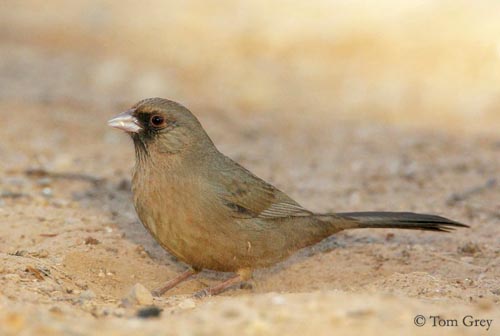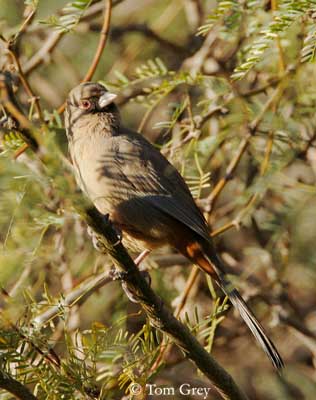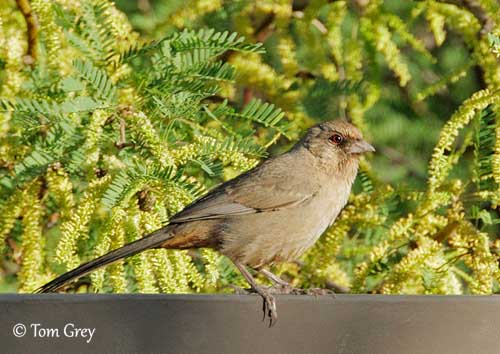
Abert’s Towhee
Pipilo aberti
Passeriforme Order – Passerellidae Family
BIOMETRICS:
Length: 21-23 cm
Wingspan: 30-33 cm
Weight: 40-54 g
LONGEVITY: Up to 8 years
DESCRIPTION:
Abert’s towhee has black face. Upperparts are cinnamon-brown. Underparts are paler grey-brown, with rusty-brown vent. Tail is long and dark, with cinnamon undertail coverts.
Bill is conical and pale grey. Eyes are black. Legs and feet are pinkish brown.
Both sexes are similar.
Juvenile is similar to adult, slightly streaked on chest.
VOICE: SOUNDS BY XENO-CANTO
Abert’s Towhee’s call is a sharp “peek”. Song is a rapid series of “peek” notes.
Fr: Tohi d’Abert
All : Schwarzkinn-Grundammer
Esp :Rascador Desértico
Ital: Pipilo di Albert
Nd: Albert-towie
Sd: Arizonabusksparv
Photographs by Tom Grey
His website:
Tom Grey's Bird Pictures
Text by Nicole Bouglouan
Sources:
A GUIDE TO THE BIRDS OF MEXICO AND NORTHERN CENTRAL AMERICA by Steve N. G. Howell, Sophie Webb - Oxford University Press - ISBN: 0198540124
FIELD GUIDE TO THE BIRDS OF NORTH AMERICA - National Geographic Society - ISBN: 0792274512
All About Birds (Cornell Lab of Ornithology)
What Bird-The ultimate Bird Guide (Mitchell Waite)
Wikipedia (Wikipedia, The Free Encyclopedia)

HABITAT:
Abert’s Towhee lives in desert woodlands, streamside thickets, at low altitude. It is also found in suburban yards and orchards.
RANGE:
Abert’s Towhee is resident in its range all year round. It breeds in Arizona and northern Mexico.
BEHAVIOUR:
Abert’s Towhee feeds on the ground, scratching soil with feet to catch invertebrates and seeds lying under the leaf litter, and then well exposed and easy to find. It also may probes bark on low trunks. It forages in thick understory.
It is a secretive bird, staying in its breeding range all year round. It prefers to stay well-hidden under bushes, and disappear into bush when intruder approaches.
Pairs usually remain bonded for life. They are monogamous and solitary nesters. They have the same territory all year round, to forage and to nest.
FLIGHT:
Abert’s Towhee performs rapid wing beats, alternated with wings pulled to sides.

REPRODUCTION:
Abert’s Towhee’s nest is built in a shrub at about 2,5 metres high, but often close to the ground. Nest is an open cup made with bits of bark, leaves and vines. It is lined with grasses and hair.
Female lays 2 to 5 pale blue eggs. Incubation lasts about 14 days, by female. Chicks hatch altricial, and fledge at about 12 to 13 days of age.
This species produces 2 broods per year, the second starting nine weeks after the first.


DIET:
Abert’s Towhee feeds mainly on seeds and insects.
PROTECTION / THREATS / STATUS:
Abert’s Towhee is threatened by fragmentation of riparian habitat and populations declined of as much as 50%, due to habitat loss.
Abert’s Towhee is a host of Brown-headed Cowbird, which parasitizes its nest.
Eggs and chicks are often preyed upon by snakes.
The American ornithologist James William Abert found the first bird, named Abert’s Towhee in his honour.